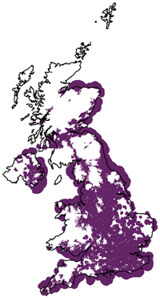This is perfectly normal because there is some separation between the older and newer platforms, though all operators are designed to roam between them with minimal disruption. With the exception of Three (3), most mobile operators will tend to stick with 2G for voice and basic data traffic, only switching to 3G if the phone both supports and demands it (i.e. when using YouTube or website browsing etc.).
Article Index:
Generally the same rule usually applies to all; better reception is good for the speed and stability of your Mobile Broadband connection, as well as power usage. We recommend readers check out our ‘Mobile Broadband Technology Information Page’ to learn more about the differences between mobile technology generations (e.g. 2G, 3G, 4G etc.). 1. Check your coverage
Vodafone Statement on Coverage Checking:
"Probably the best info we can give is that MBB performance is variable (because of location, variable building loss, time of day, density of users, etc) and so we believe that that having an accurate and honest network coverage checker is the best advice customers can have. Our new coverage checker on vodafone.co.uk www.vodafone.co.uk/coverage not only shows indoor coverage but 'variable indoor' and variable/outdoor coverage. Recently recalibrated to be far more representative of real customer experience, it's also easier to use, has detailed mapping and even includes a facility for customers to give us feedback. We don't think our competitors provide this crucial distinction between indoor and outdoor coverage, and some are even using outdated maps. We're making a further update to the coverage checker this week that adds indoor and outdoor coverage to 2G as well as 3G. It also provides an easy to read 'bars on screen' indicator of coverage for users who just want a quick synopsis rather than studying the map." Most readers will probably find the maps to be of only minimal use because it is not possible to analyse them in closer detail. Mercifully mobile operators do have their own checkers, most of which are considerably more useful. Just keep in mind that some operators might exaggerate their coverage quality.
It should also be noted that different operators will have different capacity depending on the allocation of resources and technology used in any given area; mobile transmitter positioning can also vary. In other words, just because you get a poor service with one operator (sometimes regardless of reception quality) doesn’t mean to say that all will have an identical problem.
|
 Sometimes the simplest advice is the most important and checking to make sure that the area you are intending to work within has sufficient coverage of 3G Mobile Broadband services is a critical first step. Ofcom recently released 3G coverage maps for each of the country’s five main mobile network operators (valid for December 2008), which can be downloaded and viewed in Adobe Reader .PDF format –
Sometimes the simplest advice is the most important and checking to make sure that the area you are intending to work within has sufficient coverage of 3G Mobile Broadband services is a critical first step. Ofcom recently released 3G coverage maps for each of the country’s five main mobile network operators (valid for December 2008), which can be downloaded and viewed in Adobe Reader .PDF format –